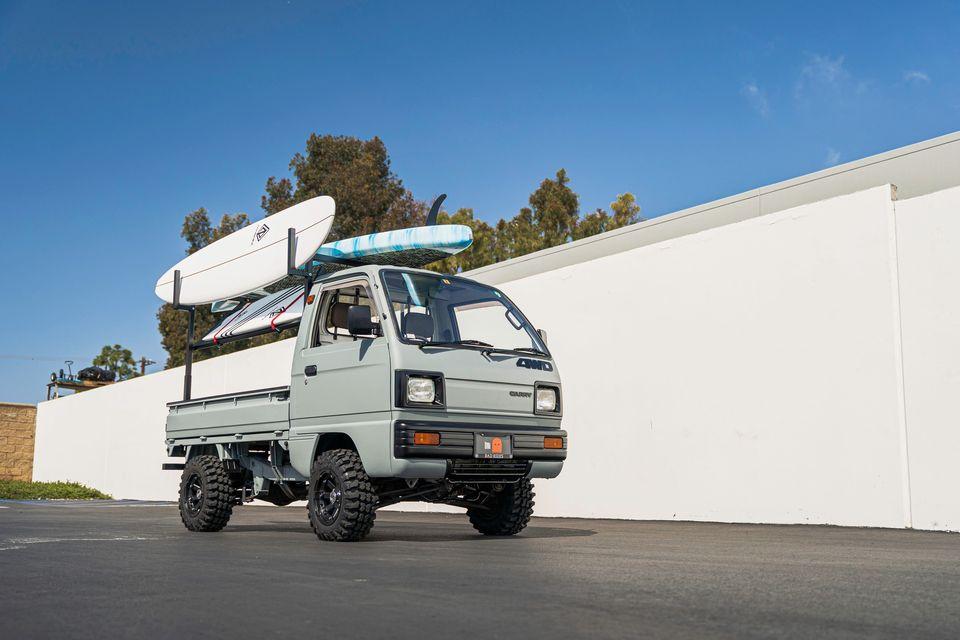So you’ve installed a lift kit on your Japanese mini truck — nice work! Whether it’s a 1.5”, 2”, or full 3” lift, your truck now sits taller, looks tougher, and is ready for more demanding terrain.
But before you hit the trail or haul your next load, there are a few important things you need to double-check. A lift kit changes your vehicle’s geometry and how its components interact — and ignoring post-install adjustments can lead to premature wear, poor handling, or worse.
Here are the 5 essential things to check after installing a lift kit on your mini truck.
🔧 1. Wheel Alignment (Especially Camber and Toe)
Lifting your truck changes suspension angles, which often throws off your alignment — especially camber and toe.
What to Check:
-
Are your front tires tilting inward (negative camber) or outward (positive camber)?
-
Is your truck pulling left or right?
-
Do the wheels feel “loose” or “floaty” at speed?
Why It Matters:
Misalignment can cause:
-
Uneven tire wear
-
Poor handling or wandering
-
Increased stress on suspension components
✅ Fix It: Get a professional 4-wheel alignment after every lift install. If your kit didn’t include camber correction bolts or plates, consider adding them now.
🔩 2. Torque on All Suspension Bolts
After driving 50–100 miles, it’s critical to retorque all the bolts you loosened or replaced during the lift install.
Key Areas:
-
Shock bolts (top and bottom)
-
Leaf spring or coil spring mounts
-
U-bolts or shackles (rear suspension)
-
Lift block or spacer hardware
-
Control arm bolts (if applicable)
Why It Matters:
Bolts can settle or loosen after initial use. If left unchecked:
-
Components may shift or detach under stress
-
Noise or clunking may occur
-
Risk of suspension failure on the trail
✅ Fix It: Use a torque wrench and re-tighten to manufacturer or kit specifications. Retorque again after 500 miles if you use your truck off-road.
🛞 3. Tire Clearance & Rubbing
With the lift kit installed, you may now be running larger tires. But even with added height, you still need to ensure no rubbing occurs during suspension travel or steering.
What to Check:
-
Full turn left and right — do tires rub on fenders, frame, or suspension arms?
-
Full suspension compression (jump on the bumper) — do tires hit wheel wells?
-
Do tires rub under load (hauling cargo or passengers)?
Why It Matters:
-
Rubbing can damage tires or body panels
-
It can reduce your ability to turn or steer in tight spots
✅ Fix It: Trim inner fender liners, add wheel spacers, or adjust tire size if needed. A little preventative work goes a long way.
🧪 4. Brake Line & Wiring Stretch
When lifting the body or suspension, you may unintentionally pull on brake lines, ABS wires, or other connections.
What to Check:
-
Are brake lines stretched at full droop (when suspension is fully extended)?
-
Are ABS sensor wires or electrical harnesses tight or kinked?
-
Any rubbing or contact with tires or moving components?
Why It Matters:
-
A stretched brake line could rupture under pressure
-
Damaged wiring can trigger ABS or 4WD system errors
✅ Fix It: Add extended brake line brackets or longer lines for lifts over 2”. Zip-tie wiring clear of moving parts and add slack where needed.
⚙️ 5. Drivetrain and CV Axle Angles
Lifting a 4WD mini truck increases the angle of your front CV axles, which can reduce their lifespan and cause vibration or clicking.
What to Check:
-
Are CV axles at a steep angle from hub to diff?
-
Do you hear clicking or popping in tight turns?
-
Is there vibration at speed in 4WD?
Why It Matters:
-
Excess angle = faster wear and higher failure risk
-
Can lead to complete axle failure on rough terrain
✅ Fix It: If you lifted more than 2”, consider CV axle shims, drop brackets, or limit straps to reduce stress. Keep axle angles as straight as possible.
✅ Bonus Tip: Test Drive and Recheck Everything
After making the above checks, take your mini truck for a controlled test drive:
-
Use a mix of pavement, gravel, and uneven terrain
-
Listen for unusual noises
-
Recheck torque and alignment after the drive
🏁 Final Thoughts
Installing a lift kit is one of the most fun and functional upgrades you can make to your mini truck. But the job’s not finished until you’ve inspected, adjusted, and verified that everything is working safely and smoothly.
Take time to double-check these 5 key areas:
-
Alignment
-
Bolt torque
-
Tire clearance
-
Brake/wire slack
-
CV axle angles
Your lifted truck will thank you — and it’ll perform better both on the farm and off the trail.
👇 Need Help Post-Lift?
Drop your:
-
Truck model & year
-
Lift size (inches)
-
Tire size
And I can recommend:
-
Alignment specs
-
Camber fix kits
-
Shock and axle upgrades
Want this as a PDF checklist or YouTube video script? Just ask!




